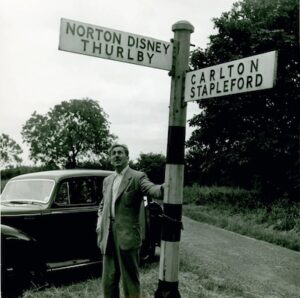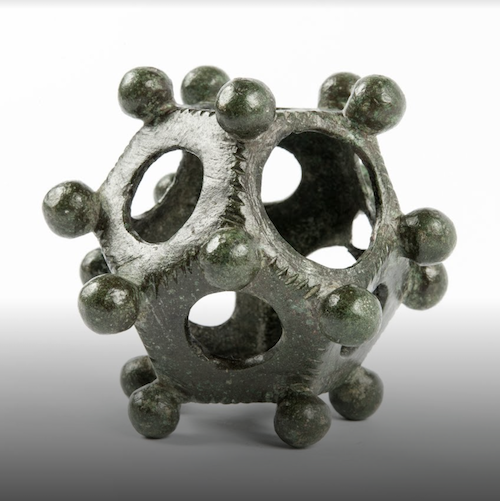
Gated Track into Gilbert’s Wood, off Wood Lane, Norton Disney, photo J. Hannan-Briggs, 3 September 2011, CCA-SA 2.0 Generic license.
Norton Disney, a small village of a little over 200 souls located in Lincolnshire in the East Midlands, summons up all one associates with such picturesque places in the English countryside. It has a long history befitting such places. Archaeological investigations have determined that it was inhabited during the Iron Age and Roman Empire before becoming the “Disnayland” estate of the d’Isigny family after the Norman Conquest. Local attractions include the remains of a Roman villa, the ruins of the d’Isgny family castle, a Manor House, an 11th century parish church named St. Peter’s, and, of course, the local pub, the Green Man.
Like other small English villages on “BritBox” TV, Norton Disney and its inhabitants have carried on quite well for decades in obscurity until the locals find themselves thrust into the news. For Norton Disney, this has happened twice in the last 75 years.

Walt Disney at Norton Disney. Courtesy the Walt Disney Family Museum, San Francisco.
First, in 1949, when American entertainment mogul, Walt Disney, made a highly publicized visit with his family to explore his own roots. Disney had reason to believe he was a descendant of the d’Isigny family, whose name had been Anglicized over time into “Disney.” While the family was forced from the area due to religious strife in the 1600s, a commemorative plaque and family graves remain in Saint Peter’s church as tangible reminders of their former prominence in the area.
Then, in 2023, excavations conducted by the local Norton Disney Archaeological Group brought the most attention to the area since Walt Disney’s visit. During those excavations, Norton Disney volunteers found an exceptionally well-preserved specimen of an enigmatic Roman era bronze dodecahedron. These twelve-sided objects cast with round holes framed by knobs have puzzled scholars since the first was recorded after being found in Aston, Hertfordshire, in 1739. Since that time, remains of over 130 other such objects have come to light in Northern Europe with some 33 being excavated in what was once Roman Britian.

Disney brass engraving, St. Peter’s Church, Norton Disney, photo J. Hannan-Briggs, 19 February 2012, CCA-SA 2.0 Generic license.
Since no documentary evidence from ancient times has survived to describe them, more theories have been posited about their use than there are sides to dodecahedron. Atlas Obscura, a website devoted to such oddities, has listed most, but not all of them:
- A specific type of dice for a game since lost to history.
- A magical object, possibly from the Celtic religion. A similar small, hollow object with protrusions was recovered from Pompeii in a box with either jewelry or items for magic.
- A toy for children.
- A weight for fishing nets.
- The head of a chieftain’s scepter.
- A kind of musical instrument.
- A tool to estimate distances and survey land, especially for military purposes.
- An instrument to estimate the size of and distance to objects on the battlefield for the benefit of the artillery.
- A device for detecting counterfeit coins.
- A calendar for determining the spring and autumn equinoxes and/or the optimal date for sowing wheat.
- A candle holder. (Wax residue was found in one or two of the objects recovered.)
- A connector for metal or wooden poles.
- A knitting tool specifically for gloves. (That would explain why no dodecahedrons were found in the warmer regions of the Empire.)
- A gauge to calibrate water pipes.
- A base for eagle standards. (Each Roman legion carried a symbolic bird on a staff into battle.)
- An astrological device used for fortune-telling. (Inscribed on a dodecahedron found in Geneva in 1982 were the Latin names for the 12 signs of the zodiac.).[2]

Dodekaeder, Stuttgart-Bad Cannstatt, 2./3. Jahrhundert nach Christus, photo Rainer Halama, Landesmuseum Württemberg, 29 December 2015, CCA-SA 4.0 International license.
In considering their purpose, three important facts stand out. First, dodecahedrons have come from areas of the Roman Empire originally populated by Celts. Second, it would have required considerable technical skill to cast them. Third, a number of specimens have been found associated with coin hoards. All these factors suggest that dodecahedrons were considered objects of value, not simply mundane gaming pieces, toys or tools. While this makes it more likely they were conceived as magical or ritual objects, another possibility focuses on the technical ability necessary to make them. Could dodecahedrons be created to demonstrate one’s craftsmanship, perhaps as a “test” for entry into a guild of metal workers? Members of the Norton Disney Archaeological Group certainly hope that their upcoming excavations will uncover more information about the use of these intriguing objects, and again shed the limelight on their picturesque village in the English countryside.
Next Installment: Angie Funds Her Hoard
Further Information:
Tibi Pulu, Archaeologists discover Roman Dodecahedron in Britain. No one knows what these things are for, ZME Science (August 27, 2024), (last visited October 14, 2024).
Samantha Tipper, Why Did Ancient Romans Make this Baffling Metal Dodecahedron? Scientific American (May 8, 2024), (last visited October 14, 2024).
Sonja Anderson, Another Mysterious Roman Dodecahedron Has Been Unearthed in England, Smithsonian Smart News (January 22, 2024), (last visited October 14, 2024).
Colin Patterson, The Lincolnshire village honoured in every Disney film since 2006, BBC News (October 23, 2023), (last visited October 15, 2024).
Ryan Gray, Mouse House: Inside the Disney village in the UK you never knew existed – and it features in every movie, The Sun (October 16, 2023), (last visited October 15, 2024).
Frank Jacobs, The Mysterious Dodecahedrons of the Roman Empire, Atlas Obscura (May 12, 2023), (last visited October 14, 2024).
[1] Peter K. Tompa is a semi-retired lawyer who resides in Washington, D.C. He has written extensively about cultural heritage issues, particularly those of interest to the numismatic trade. Peter contributed to Who Owns the Past?” (K. Fitz Gibbon, ed. Rutgers 2005). He formerly served as Executive Director of the Global Heritage Alliance and now is a member of its Board of Directors. He currently serves as the Executive Director of the International Association of Professional Numismatists. This article is a public resource for general information and opinion about cultural property issues and is not intended to be a source for legal advice. Any factual patterns discussed may or may not be inspired by real people and events. The opinions stated in this article are the author’s alone and should not be attributed to any affiliated organization.
[2] Frank Jacobs, The Mysterious Dodecahedrons of the Roman Empire, Atlas Obscura (May 12, 2023), (last visited October 14, 2024).
 Bronze dodecahedron, 12-sided object, courtesy Google Arts.
Bronze dodecahedron, 12-sided object, courtesy Google Arts. 

